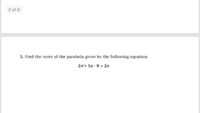rachelmaddie
Full Member
- Joined
- Aug 30, 2019
- Messages
- 851
I want to make sure my work is correct.

Find the roots of the parabola given by the following equation: 2x^2 + 5x - 9 = 2x
The formula to solve a quadratic equation of the form ax^2 + bx + c = 0
is equal to x = -b(+ / -) (b^2 - 4ac)/2a
2x^2 + 5x - 2x - 9 = 0
2x^2 + 3x - 9 = 0
where a = 2, b = 3, c = -9
Substitute in the formula
x = -3(+ / -) (3^2 - 4(2)(-9)/2(2)
x = -3(+ / -)sqrt81/4
x = -3(+ / -)9/4
x = -3(+)9/4 = 1.5
x = -3(-)9/4 = -3
Solution: The roots are x = -3 or x = 1.5

Find the roots of the parabola given by the following equation: 2x^2 + 5x - 9 = 2x
The formula to solve a quadratic equation of the form ax^2 + bx + c = 0
is equal to x = -b(+ / -) (b^2 - 4ac)/2a
2x^2 + 5x - 2x - 9 = 0
2x^2 + 3x - 9 = 0
where a = 2, b = 3, c = -9
Substitute in the formula
x = -3(+ / -) (3^2 - 4(2)(-9)/2(2)
x = -3(+ / -)sqrt81/4
x = -3(+ / -)9/4
x = -3(+)9/4 = 1.5
x = -3(-)9/4 = -3
Solution: The roots are x = -3 or x = 1.5
